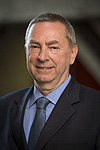Electron neutrinos from supernovae
 |
Fermilab Director
Nigel Lockyer
|
Neutrino research has the potential to lead to discoveries that rival the observation of the Higgs boson. And just as with the successful search for the Higgs, the question of the nature of neutrinos is being investigated by different teams using different methods.
Here at Fermilab we are very familiar with one method — the study of neutrinos created from high-power particle accelerators. But at last month's ELBNF collaboration meeting, Duke University Professor Kate Scholberg gave a fascinating introduction to the future use of a large, deep underground liquid-argon detector (currently referred to as ELBNF) to study neutrinos from supernovae in our galaxy. In Scholberg's words:
"When massive stars run out of nuclear fuel, they collapse in on themselves, forming ultradense neutron stars and, in some cases, even black holes. Just as gravitational potential energy turns to kinetic energy when you drop an object, the vast energy of the star's infall must be released somehow. Some will be released in an enormous supernova explosion, but 100 times more is released in the form of neutrinos, particles famous for their feeble interactions with matter. Because neutrinos interact so weakly, they escape the supernova with nearly all of the collapse energy within only tens of seconds, creating an intense burst of all three flavors of neutrinos and antineutrinos with energies of a few tens of MeV.
"Neutrinos are also known for their ability to transform from one flavor to another. The time, energy and flavor evolution of the burst not only tells the story of the star's destruction and the creation of its exotic compact progeny, but will also give us insight into the properties of neutrinos themselves. The different flavors tell different stories. The electron flavor neutrinos have a particularly interesting story to tell — they are emitted in an initial flash (tens of milliseconds) as protons and electrons are squeezed together to make neutrons and are more likely to bear the signatures of explosion processes and flavor oscillations.
"On Earth we have a chance to witness the unfolding of a Milky Way core-collapse supernova by observing the neutrino burst in large underground neutrino detectors. About four explosions per century are expected. Observing the different flavor components of the burst is a bit like making a movie in different colors.
"Different kinds of detectors are sensitive to different neutrino flavors. Existing large water and scintillator detectors (such as Super-K, IceCube, KamLAND, LVD Daya Bay and Borexino) are primarily sensitive to electron antineutrinos, which interact with free protons. Argon, in contrast, has unique sensitivity to electron neutrinos. A large underground liquid-argon detector like ELBNF would enable us to clearly record the birth of the neutron star and will bring new understanding of neutrino flavor transformation."
For more on the different ways scientists study neutrinos, I encourage you to check out symmetry magazine's article "Neutrinos, the Standard Model misfits."
|